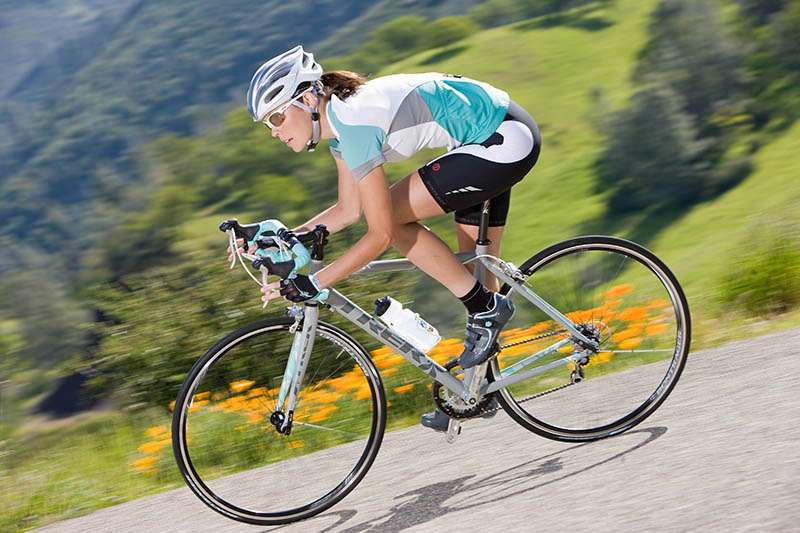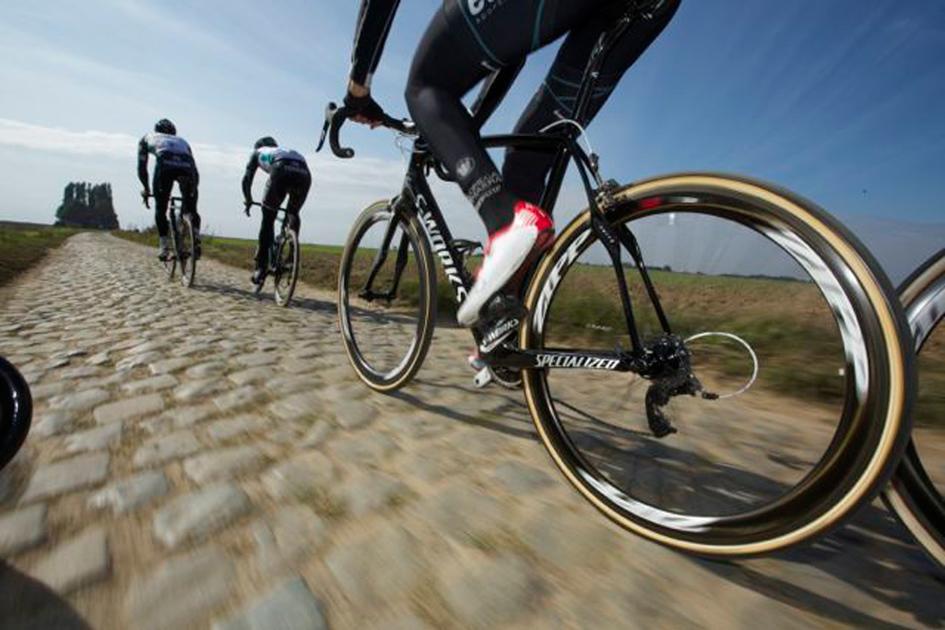The 5 Major Differences Between Men’s and Women’s Road Bikes
You’ve been riding a fitness or other type of bike for a while and have finally resolved to get yourself a dedicated road bike. You’ve got a good friend who participates in group rides with a local bike shop and you want to join in the fun.
But as a woman, you aren’t sure if you should be looking at a men’s or a women’s model.
Which one is for you?
As a female cyclist myself, I can help answer that question. But I feel compelled to admit that I have never purchased a women-specific road bike.
There are two explanations for this.
One, when I started road riding, gender-specific models didn’t exist. And when they appeared, I didn’t give them a second thought because I was happy on the bike I had.
The second, and more relevant reason for this article, is that I’m above average height for women, so I don’t require a women’s road bike for a proper fit. This is an important distinction, as women’s models are born out of the necessity to provide road frames for riders of shorter stature.
It’s an awful stereotype, but women are typically smaller than men, so they get the label. Labels aside, many men could find their ideal fit on a women’s frame as well. Being shorter in stature shouldn’t restrict anyone from getting out there and riding a road bike. Everyone deserves to ride pain free on a road bike that fits them.
I spent years selling women’s specific bikes to female customers. Terry was one of the first brands who created downsized frames fitted with 650c road wheels. The company still exists today selling primarily women’s clothing and accessories, but women can order a custom-made road bike under the Georgena Terry brand. A custom bike is more expensive than one off the rack, but it will be made for you.
As women’s cycling has grown in popularity, other brands such as Cannondale, and Liv (Giant) have brought women’s road bikes to the sales floor. As a brand, Liv has done an exceptional and intelligent job of creating an entire infrastructure to support their women’s products. All of their information and how-to videos are done by women for women.
If you’re an on-line shopper, Canyon (WMN) sells great values in women’s road bicycles delivered directly to your front door. Specialized and Trek used to be in the women’s game, but not anymore. Their philosophies are based on rider size only, and not gender labels. Instead, these two brands rely on changing out certain components and accessories to achieve a perfect fit.
Now, let’s take a closer look at the differences between a men and women road bike.
On This Page
Frame Geometry
Bicycle manufacturers have adapted traditional road bike frame geometry to accommodate the different shapes and sizes of women, and in particular, the principle that women have shorter torsos and inseams.
These anatomical differences mean shorter female riders may have a harder time reaching the handlebars and comfortably getting on and off a men’s bicycle.
Easily reaching the handlebars is an important component of bicycle safety, control, and handling. If the reach is too far, and the rider is overextended, this could lead to back pain, not to mention potential discomfort down there. Reducing the length of the top tube (the tube that connects the saddle to the handlebars) resolves reach, handling, safety, and rider control.
A slanted or sloped top tube reduces the distance between the seat and handlebars (for reach) and facilitates mounting and dismounting the bicycle.
Many bicycle manufacturers use this common technique so that their frames meet a wider variety of rider sizes. With a sloped top tube, brands can produce a fewer number of frame sizes to still serve the masses.
The top tubes of non-sloping women’s road frames will be shorter in length than a men’s bike. Shortening the top tube means that the geometry of the bike changes slightly, forcing a higher stack height to improve rider reach by positioning the rider more upright.
If you aren’t familiar with tube names or parts of a bicycle, you can find detailed information here.
Frame Size
Conventional road frame measuring techniques are not viable with slanted top tubes, so sizing guides, similar to clothing, help riders determine the correct size.
Women who fall in the petite category (under 145 cm or 4’9”), are hard-pressed to find stock road bikes small enough for them and may want to consider a custom-built frameset with 650 road wheels.
Here’s how some of the more mainstream brands tackle their sizing :
- Cannondale has kept traditional sizing methods (44 to 54 cm) for their women’s road bikes, but you have to look for Women’s in the bike’s name.
- Specialized offers complete road bikes from 44 cm as well, but they don’t carry any specific gender label
- Canyon (WMN) sells sizes from 3XS through M and requests the input of the cyclist’s height and inseam to determine proper sizing.
Be aware that, in terms of sizing, overlap exists between Men’s and Women’s road bikes. If the women’s sizing guide places you on a 51 to 54 cm bicycle, there’s most likely a men’s equivalent. However, a women’s 51 may not be the same as a men’s 51. You’ve just got to try them both.
Compare frame geometry and stock stem and handlebar width to see which one is best for you. It may save you the extra cost and hassle of changing some parts out later.
I used to tell customers to think of bike brands like Coke and Pepsi. They are both colas, but you like one better because you just do.
Female-Specific Components
Another way women improve road bicycle fit is to make component changes better adapted to their size. Other than pure frame geometry, components designed with women in mind are the best way to adapt a road frame to a female rider.
The primary candidates are the saddle, stem, handlebar, and crank arm length.
Saddles
In my eyes, the saddle is the only true women-specific component that is different from the men’s version in shape and form. Women’s hips are broader because we bear the children. As a result, our sit bones are further apart than those of our masculine counterparts. This variation in distance means women sit on saddles differently.
To be comfortable hours on the road, women’s saddles are wider and flatter on the top and shorter in length.
However, too wide is not the way to go either. Most experienced bicycle shops will have special devices to determine the width of your sit bones and the saddle you need to be comfortable on your bike. If they don’t, you can do it at home on your own.
While you may not need a gender-specific saddle, it’s great to know there’s a choice. If your perfect fit is only a few millimeters away, saddles can be moved forward or aft on their rails too.
Finding the right saddle can take a bit of trial and error, so be patient.
Most reputable bike shops have saddles you can test before you buy. Don’t hesitate to ask.
Stems
When the top tube has been sloped, and your women-specific geometry is still a touch too long, it’s time to change the stem.
Stems don’t carry women-specific labels, but they do come in a wide variety of lengths and rises (heights). And making a stem change to dial in your bike reach won’t break the bank.
Women tend to opt for stems between 80 to 100mm in length, but even shorter ones exist, it all depends on your anatomy.
Regardless of your choice, be sure you have some length to your stem so your bike handles properly. To accomplish this, some weight needs to be over the top of the headset and in front of the bike.
If your reach is too short because you don’t have enough, the handling gets twitchy, especially on downhills.
Handlebars
Women traditionally have narrow shoulders and require narrower handlebars on road bikes. Having a correctly sized handlebar will facilitate breathing when you’re working hard, give you a comfortable ride, improve your handling, braking reach and road cycling experience overall.
Fortunately for women, many third-party brands sell excellent models starting as narrow as 38 cm. I know of no women-specific handlebars, they are gender neutral and sold by width only. If you want to find out exactly which size is right for you, take a few minutes to watch this.
Crank Arm Length And Lever Reach
Like handlebars and stems, there are no women-specific cranks or levers.
Depending on leg length, some riders may find it necessary to swap out stock 175 or 172.5 mm road cranks for shorter ones such as 165 mm. To some bike fitters, crank arm length is only second to saddle height in importance.
Certain bicycle disciples are known for specific crank lengths, but everyone’s needs vary, so don’t be concerned about stereotypes.
Replacing crank arms, and sometimes the entire crankset, can be expensive, so consult with a bike fit expert to help you decide if you need a change and which length is ideal for you. Many experienced shops may have a bike fitter on staff or know one you can contact directly. It’s an investment, but a worthy one.
Major groupset brands such as Shimano and SRAM have made it possible for road riders with smaller hands, or those in need of a few extra millimeters to dial in their reach, to reduce the distance between the shifter lever and handlebar.
If this isn’t an option for you, or you still need a smidgen more, repositioning the levers higher on the handlebars may be an option as well. Here are a few great tips to show you how to make sure your levers are in an optimal position.
Color Scheme and Paint Job
My thoughts on the majority of today’s color schemes for the feminine market (bikes, clothing and accessories) are clear. I don’t understand them, period.
Just because I am a woman doesn’t mean I want to look like an Easter egg or wear society-defined gender specific colors (pinks and purples!) full of glitter, swirls, flowers, and butterflies.
I don’t define my femininity by what I wear, but hey, that’s me, to each her own. Luckily trends are shifting and brands are starting to understand the importance of creating more neutral products suitable for men and women alike.
As a consumer, if I want it, I’ll look for it. Just don’t force it on me.
650c Wheels
Manufacturers who produce stock women’s road bikes in the smallest sizes routinely make the choice of providing 650c road wheels in place of traditional 700c wheels.
Though it isn’t as common these days (it was the calling card for those Terry bikes), brands such as Canyon (WMN) have made them stock on their 3XS and 2XS sized frames.
650c wheels have a smaller diameter, which immediately brings down the stand over height and shortens the top tube for improved reach.
Using 650c wheels on smaller road bikes maintains proper handling while preserving the look of its 700c sibling. 650c wheels and tires are easier to find these days too since they are becoming popular on gravel bikes.
Author Recommended Reads




